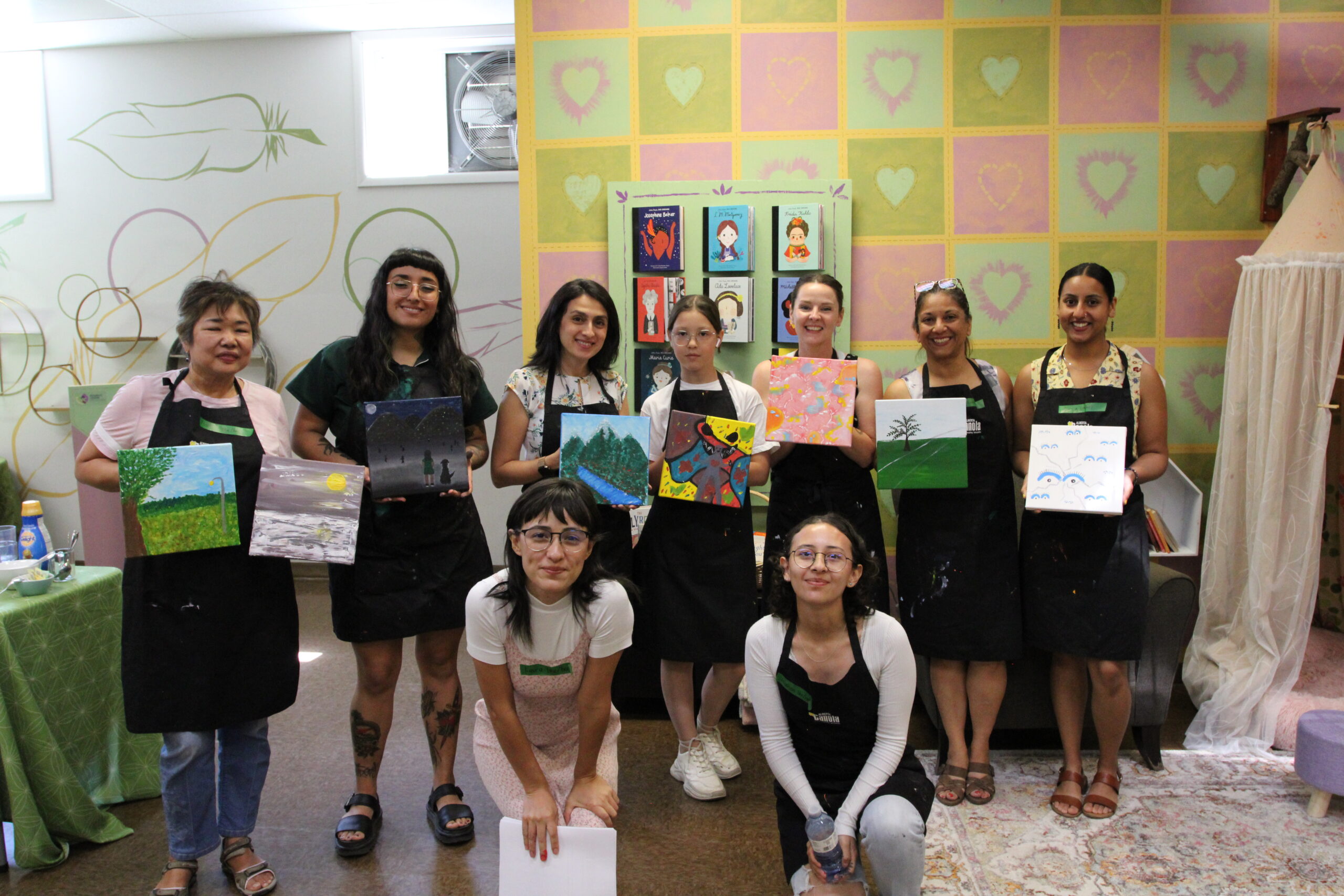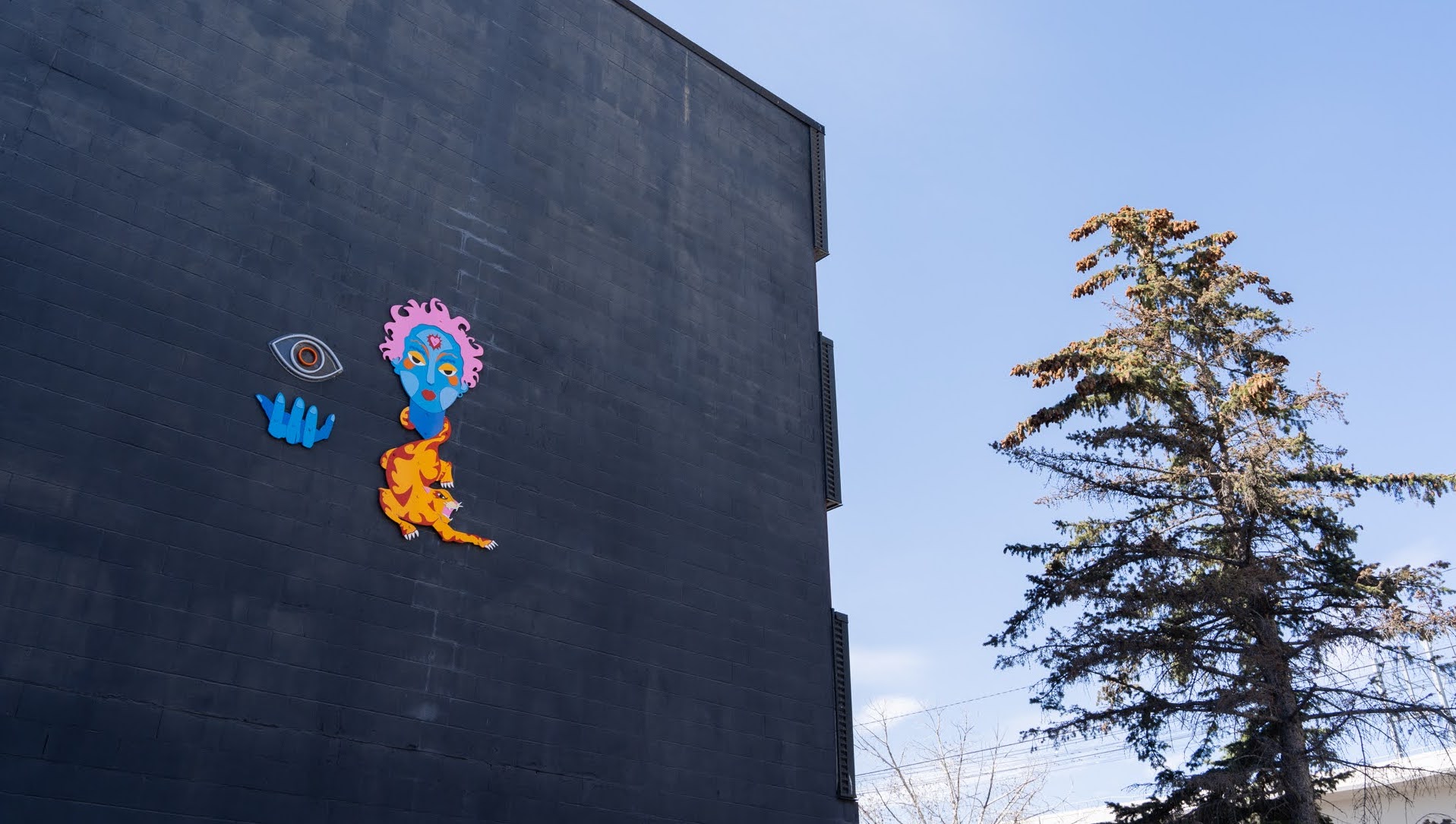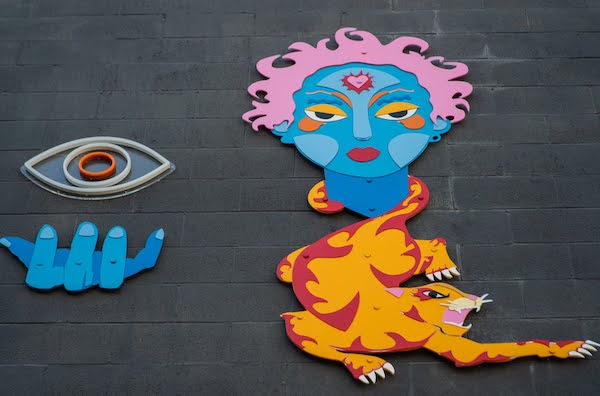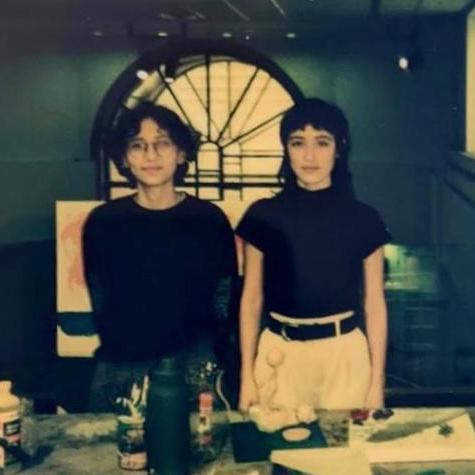What does “safe space” look like?
An interview with CreateSpace Artist Duo RAZA
During their CreateSpace Public Art Residency, artist duo RAZA (sisters Laura and Valentina Caraballo) asked women-identifying people of Calgary to represent safety in public space. The motifs and themes they received in response informed their new public art installation, Guardiana, in downtown Calgary.
With clear influence from both Laura’s education in political science and Valentina’s background in visual art, RAZA explores how we exist in public space. Through different lenses–tactical urbanism, art historical representations, and feminisms– RAZA raises questions on our city spaces with a focus on broadening the conversation. Belinda Uwase, STEPS’ Artist Programs Coordinator, interviewed the artist duo on the process, intention, and takeaways from their year-long public art residency.
Belinda: Can you tell us a bit about the project you worked on as part of the CreateSpace Public Art Residency?
Laura: During our STEPS residency program, we created an artwork titled “Guardiana”, which is a combination of acrylic installation and neon.
Valentina: The project is based on community engagement and research-oriented creation. We connected directly with local women’s organizations like the Women’s Center of Calgary, Skipping Stone, which is a trans-affirming organization, and the CIWA. Through them, we connected to specific demographics of women in the city. We held two different workshops where we asked what safety looked like for them, and as a response they would create a painting. It was very interesting to see many motifs and repetition of images and understandings; it was very human-oriented.
Laura: When we were selected for the residency, we started immediately working on the concept. Something that came up very organically was: how do we want to enter this space with our first public art piece? What’s important to us? And so before everything, we started researching public space, the design, or the lack of certain elements that put a wide range of identities in a place of vulnerability.
That triggered a larger conversation about how women experience public space from an intersectionality perspective. And that’s the reason we wanted to better understand other people’s experiences and have a more holistic perspective of what safety and vulnerability mean. We started the workshops in that way: we shared a bit of the research that we had done to reassure everyone in their room that the vulnerability that we experience in public space is not necessarily inherently because we are female presenting, but because of a lack in the design of urban spaces.
Valentina: And to specify what is missing from the urban design, the primary three that we encountered were presence, lighting…
Laura: And representation. Lighting is to be able to understand who’s in the space, who’s on the other side of the street for example. Another one was “I”: inherently having a presence in space makes it safer. And the third one was the diversity within that presence and the people within that space–having many different identities from different ages, ethnicities and diverse groups makes this space safer. For woman-identifying individuals, if you see someone within your same spectrum, you just start feeling safe.
We brought this research to the workshop, but we made the workshops very lighthearted, so everything centred on art. We tried avoiding triggering any type of bad experiences in the public space. We had really beautiful pieces and it was just a fun conversation, understanding everyone’s experience and hearing a little bit more about what safety means for them.

RAZA with participants from their arts-based workshop in Calgary.
Belinda: It really shows how passionate you are about this work and the consideration to community, which is something that we really try to push as a part of the residency, especially as emerging artists or people newer to public art. I’m interested to know how you came to want to have workshops and to have that genuine community engagement to consider the spaces that you’re activating…was that influenced by the residency or is that something that you knew that you wanted to integrate into your project from the beginning?
Valentina: I think it was something that was largely facilitated by the residency, but I think that the desire came from an exhibition we created called Lasers of Sentiment. We were very fulfilled with being able to connect to other immigrants, but we also realized the opportunity to expand that connection. That sensation and the familiarity and community that it can bring you could be magnified in the public space. So I think with that in mind, we wanted to go with both a personal approach as if we were talking to family, and then also with a more historic and systematic understanding, because I feel like that’s the sweet middle spot. When you become too non-familiar and you talk about numbers and consequences, you lose the humanity of it. And I feel like what makes this valuable is the humanity of it.
What motivates us the most is actually seeing how people benefit from this experience. So I think that’s definitely something that made us want to focus on workshops and direct community connection. But we also included the research approach because I think connecting those two can give us a bigger and clearer image of what the circumstance is.
Laura: The reason we created the workshops originally, as Valentina said, was our previous experience with community engagement. And that’s how RAZA came to be; it was about understanding if our experiences were also other people’s experiences. If someone else was feeling this way, how were they dealing with it? Like going through different experiences of, for example, being an immigrant, being a woman, being a POC…all these types of identities. We wanted to understand how other people navigated that. We created the workshops mainly because we wanted to contribute back to the community and connect through art, but also provide something that they will find enjoyable, that they will learn.
As I mentioned, we touched on a lot of points about urban design and urbanism, but we also were able to instruct a workshop that was more art-focused: teaching colors and the color palette, or how to create a concept. But at the end of the day, what was incredibly fun about connecting with these people was being able to hear their experiences. And so that was a very fulfilling experience in general and it really fit onto the overall design for the piece.

Guardiana installed in Calgary
Photo credit: May Shi
Jennifer Smith was an incredible mentor and really gave us a perspective that we had never thought of on how to recognize creative input and community engagement in art. During the workshop we allowed people to choose if they wanted to be recognized as an art contributor to the project, and if they agreed we acknowledged them in the recognition plate. Jen had a big impact on how to navigate that and counterbalance having community input, while also providing opportunities and advantages to being part of creating public arts.
Valentina: A fair exchange of information, you know?
Belinda: I love that. My next question is why were you interested in taking part in the public art residency?
Laura: We are emerging artists; our first exhibition was here in Calgary. It was an exhibition that was based on our upbringing in Colombia and all the things that were involved there. And it was just beautiful, the whole experience, but it always left us feeling like we weren’t reaching the people that we wanted to. And so we spoke with the team at a mohkinstsis/Calgary-based gallery and we all had the same thoughts on how historically exclusionary the gallery space has been. We thought public art was an opportunity to have those conversations on a larger scale. I think it’s more powerful and it reaches an audience that we didn’t feel like we were connecting with through the gallery space.
STEPS really caught our attention the first time I saw the call to artists mainly because it was all about changing the built environment and just empowering artists and communities to create the change that they wanted to see…it kind of changed my way of thinking about how I wanted to enter the public art [milieu]. And we saw an opportunity with STEPS to make it the way we wanted to.
Valentina: It’s an alignment of intention; public art can be something that fits the art world and the evolution of our cities and tourism and all those things, but it can also be an opportunity for the improvement of our societies. So I think it’s mainly that factor that made us feel strongly akin to STEPS.
Belinda: Thank you. Another question I had was what impact do you hope to see from your participation in this project? Which could speak to, as you mentioned, safer spaces, or anything that you want to elaborate on.
Valentina: This project has meant a lot to us. This experience has provided us with a deeper understanding of what public art is. Sometimes we see muralism and we consider that to be the end of it. But the reality of it is that public art is a lot about planning and a lot about learning. And so this experience has definitely made us into better artists in the sense that we have a stronger understanding of what we’re doing. And it’s made us more confident to continue to pursue public art in the future and to do it in a way that we’re proud of doing.
Laura: To add onto that same point about the learning curve; I think that’s where STEPS really helped us. We had really amazing mentors that were constantly supporting us and feeding us information that was extremely important for us to be able to succeed in this residency. I think that we feel way more confident moving forward with our practice in public art.
And in regards to the impact of Guardiana, I think that when we first thought about the concept, I don’t think we ever thought that Guardiana was going to be the end of a conversation or finalizing a conversation…it was more so contributing to that conversation and maybe highlighting the importance of that.
Especially coming out of the COVID-19 pandemic, we should all be safe and we should all be able to discover cities and get all the advantages of being outdoors. And so we wanted to contribute to the conversation of equity and accessibility to public space.
Valentina: I want to add to that idea of what accessibility is because it’s a big umbrella word. But when we were thinking of accessibility in this case, it was in the reality that safety doesn’t only mean that “I can walk down this street”; safety also means that down this street is a better opportunity for me, better connections, better resources, knowledge, et cetera, but if I don’t feel safe going down this street, then I don’t feel safe entering that space. And so people stay outside of this circle of information that can be extremely valuable to their progression as a human being and the opportunities they get to have in this world. So I think in that reality, it’s almost like the statement is: public space is where we are all from and we all should have the opportunity to be here. It shouldn’t even be a discussion, it’s just our space.

The public art installation by RAZA features a neon component beside the acrylic figure
Photo credit: May Shi
Belinda: I really like that you mention that it’s not the end of a conversation. We talked about the significance of temporary public artwork in the sense that it actually highlights or uncovers how exclusionary these systems can be to a lot of communities. And it really does impact the way that people navigate through space, so I think that’s really important.
I also wanted to discuss your choice of colors and how you came to design the work.
Valentina: The design is a combination of a lot of different directions. For instance, with the eye being neon, we are responding to the research we underwent about simple things that can provide us with a perceived sense of safety in public space. The main figure is heavily inspired by the workshops and the motifs we saw come up over and over again. We had a participant who told us that when she was in Chile with her dog she felt way safer walking on the streets and she could go out at night and explore the city in a different way. So from that narrative, we came up with the idea of bringing a natural creature to protect the female-presenting image.
We brought the imagery of the cat specifically because cats have a lot of association with witches, which were women that were persecuted for breaking societal standards. So we decided to bring a feline image with a sharp element to it. You can see [the way the figure looks at you] is with relaxed eyes…and she has a heart on her forehead, which indicates to you that she’s not out to hurt anybody. But the fact that she has a cat coming out of her chest is recognizing that she has a protector and she has the capacity to defend herself.
The colours were my favourite part because at that time I was researching a lot on Hinduism—about their deities and how they’re represented and what they signify. I found this figure named Kali, [the master of time]. With time you can bring things to birth, but you can also fully destroy them. I feel like this is the energy Guardiana has: she’s creation, but she can also be destructive. And that’s something about this piece that brings a lot of passion.
Laura: With Guardiana, we hoped to create an artwork that accompanies and provides a sense of safety, representation and belonging to the woman-identifying people of Calgary. And so, although it’s not the end of the conversation, we hope that this piece brings some sort of safety to the women that need to access this Sunalta community center or the train station or the outdoors and spaces surrounding the area where the piece will be installed.
“Guardiana” is installed at 1615 10 Ave SW. in Calgary, Alberta
About

RAZA
Laura and Valentina Caraballo
RAZA is a transregional multi-medium art collective based in Calgary formed by Colombian artists Valentina and Laura Caraballo. Their artistic practice explores ways to further their understanding of self and the social world through art by developing concepts from a psychosocial approach. RAZA’s current work focuses on engaging with underrepresented groups in marginalized communities to create art that contributes to the pursuit of equity in the public space realm. The duo is working towards creating interactive public art pieces that invite both past and present inhabitants of the land to engage and create new perceptions of the land through art.
Supporters
The 2022 CreateSpace Residency is supported by the City of Toronto as part of ArtworxTO: Toronto’s Year of Public Art 2021 – 2022, TD Bank Group through the TD Ready Commitment, Canada Council for the Arts, and Ontario Arts Council. We also acknowledge the support of the Canadian Race Relations Foundation with funding provided by the Government of Canada.


